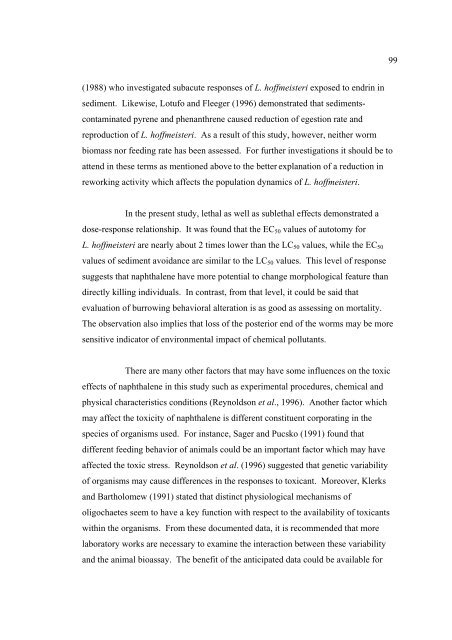THESIS APPROVAL
THESIS APPROVAL
THESIS APPROVAL
You also want an ePaper? Increase the reach of your titles
YUMPU automatically turns print PDFs into web optimized ePapers that Google loves.
(1988) who investigated subacute responses of L. hoffmeisteri exposed to endrin in<br />
sediment. Likewise, Lotufo and Fleeger (1996) demonstrated that sedimentscontaminated<br />
pyrene and phenanthrene caused reduction of egestion rate and<br />
reproduction of L. hoffmeisteri. As a result of this study, however, neither worm<br />
biomass nor feeding rate has been assessed. For further investigations it should be to<br />
attend in these terms as mentioned above to the better explanation of a reduction in<br />
reworking activity which affects the population dynamics of L. hoffmeisteri.<br />
In the present study, lethal as well as sublethal effects demonstrated a<br />
dose-response relationship. It was found that the EC50 values of autotomy for<br />
L. hoffmeisteri are nearly about 2 times lower than the LC50 values, while the EC50<br />
values of sediment avoidance are similar to the LC50 values. This level of response<br />
suggests that naphthalene have more potential to change morphological feature than<br />
directly killing individuals. In contrast, from that level, it could be said that<br />
evaluation of burrowing behavioral alteration is as good as assessing on mortality.<br />
The observation also implies that loss of the posterior end of the worms may be more<br />
sensitive indicator of environmental impact of chemical pollutants.<br />
There are many other factors that may have some influences on the toxic<br />
effects of naphthalene in this study such as experimental procedures, chemical and<br />
physical characteristics conditions (Reynoldson et al., 1996). Another factor which<br />
may affect the toxicity of naphthalene is different constituent corporating in the<br />
species of organisms used. For instance, Sager and Pucsko (1991) found that<br />
different feeding behavior of animals could be an important factor which may have<br />
affected the toxic stress. Reynoldson et al. (1996) suggested that genetic variability<br />
of organisms may cause differences in the responses to toxicant. Moreover, Klerks<br />
and Bartholomew (1991) stated that distinct physiological mechanisms of<br />
oligochaetes seem to have a key function with respect to the availability of toxicants<br />
within the organisms. From these documented data, it is recommended that more<br />
laboratory works are necessary to examine the interaction between these variability<br />
and the animal bioassay. The benefit of the anticipated data could be available for<br />
99
















